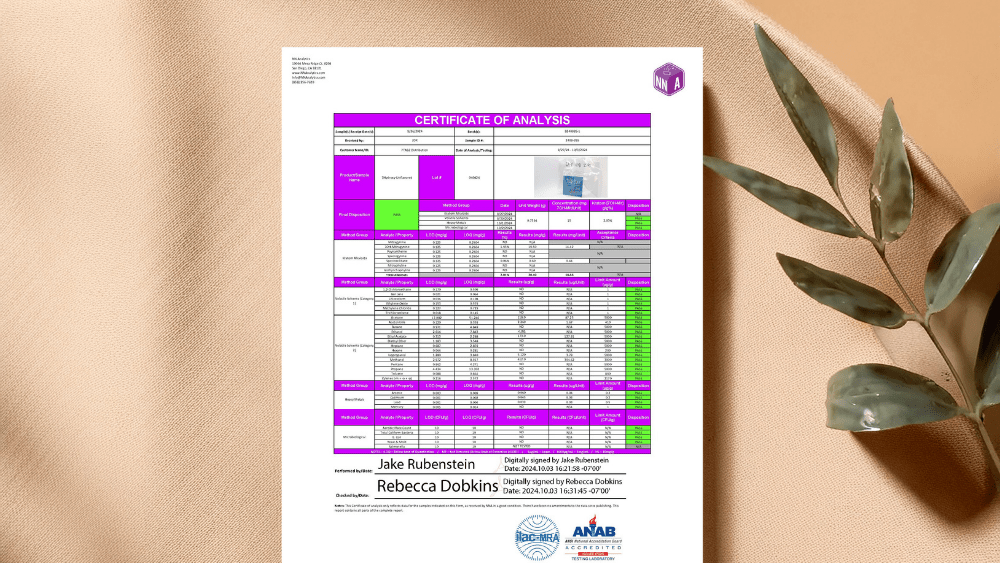
How to Read a 7-OH Certificate of Analysis
When exploring 7-hydroxymitragynine (7-OH) products, one of the most important tools available to consumers is the Certificate of Analysis (CoA)—also known as a Certificate of Compliance.
This document, typically issued by a third-party laboratory, provides detailed insights into a product’s composition, contaminant screening, and production quality. But what should you look for on a CoA, and how can you tell if a brand is being transparent?
In this guide, we’ll break down the key elements of a 7-OH CoA, explain why they matter, and show you where to find them—especially from brands like 7Tabz.
What Is a 7-OH Certificate of Analysis?
A Certificate of Analysis (CoA) is a third-party laboratory report that verifies the contents of a product. For 7-OH brands, it typically includes:
-
Alkaloid content breakdown (including 7-hydroxymitragynine)
-
Screening for contaminants (heavy metals, pesticides, microbial activity)
-
Batch numbers and dates
-
Testing methodology and lab credentials
This document is crucial for product verification and quality assurance, particularly in emerging spaces where regulatory oversight is variable.
Why Are Certificates of Analysis Important?
In the unregulated world of botanical extracts and kratom-derived compounds, Certificates of Analysis provide essential accountability. A CoA offers consumers an objective view into the quality and product integrity of what they’re purchasing, with measurable, third-party data..
Here’s why CoAs matter:
-
✅ Verification: Confirms that 7-OH content is accurately represented
-
✅Quality: Screens for contaminants like heavy metals or bacteria
-
✅ Transparency: Builds trust through third-party validation
-
✅ Traceability: Links specific test results to individual batches
Brands that publish these documents publicly, like 7Tabz, are taking important steps toward increased transparency and traceable documentation.
Key Elements to Look For in a 7-OH CoA
1. Batch Number & Date
Each CoA should list the exact batch or lot number tested, along with the testing date. This ensures you’re looking at a specific report for the product you received, not a generic or outdated certificate.
2. Alkaloid Profile
A high-quality CoA will list the percentage or milligram content of primary alkaloids. In the case of 7-OH products, look for:
-
7-hydroxymitragynine (7-OH)
-
Mitragynine, if applicable
-
Other alkaloids, depending on the formulation
Note: This section should not include commentary about the results, just raw data.
3. Contaminant Testing
Third-party labs should screen for:
-
Heavy metals (lead, mercury, arsenic, cadmium)
-
Pesticides
-
Pathogens (E. coli, Salmonella, mold, yeast)
All values must fall within acceptable thresholds found in U.S. or international guidelines.
4. Testing Lab Credentials
The bottom of the CoA often includes the name and credentials of the testing facility. Labs should be independent (not in-house), and ideally ISO-accredited for analytical testing.
How To Find Certificates of Analysis
Reputable 7-OH brands typically offer CoAs through one of the following methods:
Step 1. Look for QR Codes on Packaging
Brands like 7Tabz include QR codes that link directly to a batch-specific CoA.
Step 2. Review Dedicated Lab Results Page
Some vendors maintain a centralized lab results section on their website.
Step 3. Request Lab Results (If Needed)
If you don’t see a CoA online, you can contact customer support and ask for documentation tied to your batch number.
If a company doesn’t publish CoAs or offers only generic versions without batch info, it may be a sign to look elsewhere.
Why QR Codes Matter
Brands like 7Tabz include batch-specific QR codes on product packaging. When scanned, these codes lead directly to the CoA for that particular batch, ensuring that what you see online matches what’s in your product.
This kind of traceability builds trust and reinforces the brand’s commitment to transparency.
Red Flags to Watch Out For
-
No lab name listed
-
Generic or reused CoAs
-
Missing dates or batch numbers
-
No screening for contaminants
-
Documents hosted as images without metadata
If a brand can't provide a clear, third-party CoA for each batch, that's a warning sign.
Exploring 7-OH Certificates of Analysis
Understanding how to read a Certificate of Analysis allows you to evaluate 7-OH products based on transparent, third-party lab documentation. Whether you are comparing brands or verifying your most recent purchase, a reliable CoA is your best tool for assessing product quality and transparency.
Brands like 7Tabz set the standard by making this information readily available—often directly from the packaging. In a developing market, that level of openness isn't just a bonus, it's essential.
Visit 7Tabz to view their batch-specific lab results and learn more about their testing process.
